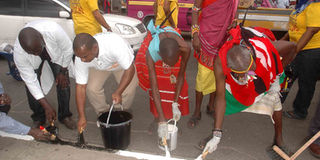Magic paint that could greatly reduce traffic chaos

Mombasa County workers and local residents paint part of the Makupa highway. We could and should do road markings like the French do. So correct and so consistent and so big and so bold that they act like massive psychological walls that everybody understands. PHOTO | FILE
What you need to know:
- Emulating all the ingredients to achieve that on our roads would take more time and money than we’ve got or are likely to get. But there was one crucial part of their system which was more beneficial than any other, which helped everything else work optimally, that we could afford.
- They are absolutely unmistakable and unmissable. They are a constant and powerful guide and conduct control. They create and maintain and assure channels of flow. They automatically “police” the mind of every driver s
- We could and should do road markings like the French do. So correct and so consistent and so big and so bold that they act like massive psychological walls that everybody understands, everybody obeys, and everybody knows all other road users will comply with.
There’s a magic ingredient which could help transform Kenya’s traffic flows, road conduct and road safety more quickly, more cheaply and more completely than perhaps any other single measure. It’s called “paint”.
And if you want to know how and why, go to France. They use all sorts of cunning things — like smooth tarmac, signposts, roadworthy vehicles, competent drivers, and rational speed limits — to deliver almost perfect motoring conditions everywhere; from the heart of big cities to the top of precipitous mountain ranges, through forests and tiny villages to vast valleys and plains.
In 2,500km of motoring across all that recently, I did not see a single pothole, nor any misplaced or missing signpost, nor any dangerous or disruptive manoeuvre. The system worked so well that even long-distance and mixed journey times could be calculated to the nearest minute by dividing section distances by section maximum speeds. Because every vehicle, in every speed zone (which ranged from 30kph to 130kph) drove at the stipulated speed. Not much faster, and most certainly not slower.
Emulating all the ingredients to achieve that on our roads would take more time and money than we’ve got or are likely to get. But there was one crucial part of their system which was more beneficial than any other, which helped everything else work optimally, that we could afford.
PSYCHOLOGICAL WALLS
That was the road markings. Paint. In the budget of building a road, that item is petty cash. With the right machinery and skilled operators, we could upgrade hundreds of kilometres of road per week, every week.
And we could (and would need to) do it properly. Not the sometimes there, sometimes not, sometimes right and sometimes wrong semi-visible scribbles that we have ineptly doodled in the past.
We could and should do road markings like the French do. So correct and so consistent and so big and so bold that they act like massive psychological walls that everybody understands, everybody obeys, and everybody knows all other road users will comply with.
Their lines look as though they were painted only yesterday. And as if they were applied by someone who knew how to drive and had actually visited the place where instructions on a job card became paint on tarmac. And their skinniest lines are twice as wide as ours; their thicker lines are twice as wide.
They are absolutely unmistakable and unmissable. They are a constant and powerful guide and conduct control. They create and maintain and assure channels of flow. They automatically “police” the mind of every driver so all 30 million of them know exactly what they must do and what everybody else will do. It works.
It would improve our road conduct and motoring experience enormously, even if shortages of resources and/or competence delayed other optimising measures. Among other benefits, such road markings would expose, even to those who cannot see what is already obvious, that the greatest threat to good order and swift progress is not vehicles that go a bit too fast, but those which go a lot too slowly.
We would need, rigorously and perhaps ruthlessly, to apprehend any vehicle in the flow which did not maintain the stipulated speed, and either send the driver back to school or the vehicle back to the garage. Or both.





